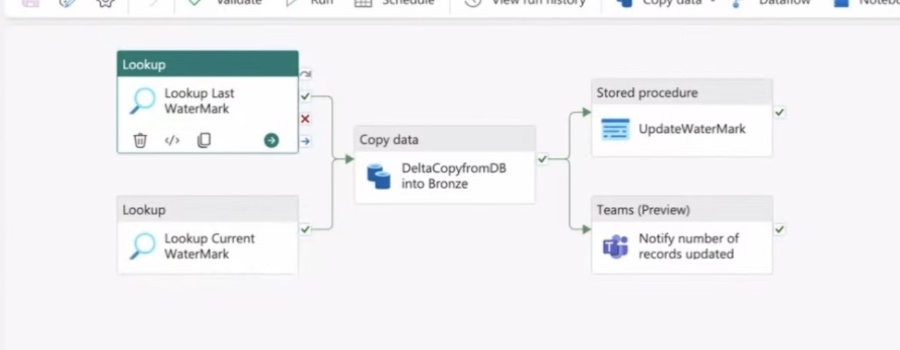
Optimize Data Design with Lakehouse Patterns | Microsoft
Unlock Lakehouse Success: Explore Medallion Architecture in our Fabric Espresso episode!
Key insights
- Medallion Architecture is a data design pattern in lakehouses, aiming to improve data structure and quality through Bronze ⇒ Silver ⇒ Gold layer tables.
- Databricks offers Delta Live Tables (DLT) for building data pipelines with streaming tables that are incrementally updated, utilizing Apache Spark™️ Structured Streaming.
- The Bronze layer captures raw data from external sources, focusing on Change Data Capture and historical archive, ensuring data lineage and reprocessability.
- The Silver layer cleanses and conforms data, providing an Enterprise view for self-service analytics, leveraging minimal transformations for speed and agility.
- The Gold layer houses consumption-ready, project-specific databases optimized for reporting, using more de-normalized and read-optimized data models.
Understanding Medallion Architecture in Data Lakehouses
Medallion Architecture offers a sophisticated approach to organizing and managing data within Microsoft Fabric Data Factory, tailored for lakehouse environments. This architecture stands out by providing a structured way to enhance data quality and structure as it transitions through its three core layers: Bronze, Silver, and Gold. At the Bronze layer, raw data from external sources is captured and archived, laying the groundwork for further processing.
The Silver layer primarily handles the cleansing and conformation of data, preparing it for enterprise-wide analytics by applying minimal yet essential transformations. Finally, the Gold layer focuses on curating data for specific business consumption needs, utilizing de-normalized models for more efficient data retrieval and analysis.

By implementing the Medallion Architecture, enterprises are empowered to make informed decisions rapidly, thanks to the streamlined data flow and improved data quality across layers. Moreover, this architecture supports the use of cutting-edge tools like Databricks' Delta Live Tables, facilitating the building of efficient and up-to-date data pipelines. It not only simplifies the data modeling process but also fosters a more agile and scalable analytical ecosystem, ultimately leading to deeper insights and driving advanced business outcomes.

In this episode of Fabric Espresso, Abhishek and Estera explore the Medallion Architecture Data Design and Lakehouse Patterns in Microsoft Fabric Data Factory. The medallion architecture, a data design pattern, is focused on organizing data within a lakehouse. Its main goal is to enhance the structure and quality of data across its different layers (Bronze to Silver to Gold).
Medallion architectures, often called "multi-hop" architectures, enable incremental and progressive data improvement. Databricks provides tools like Delta Live Tables (DLT) for easy pipeline creation. These pipelines, built on structured streaming, are designed for incremental refresh and update.
At the Bronze layer, raw data is initially processed, capturing valuable metadata. The Silver layer then enhances this data, making it enterprise-ready by performing just-enough cleansing and merging. This stage is crucial for creating an "Enterprise view" of key business entities and concepts.
Transformations at the Silver layer are minimal, adhering to the ELT methodology over the traditional ETL. The focus here is on speed and agility. Finally, the Gold layer organizes data into consumption-ready databases. This layer is optimized for reporting, utilizing de-normalized and read-optimized data models.
The lakehouse architecture not only simplifies data management but also enables advanced analytics and ML on a unified platform. A lakehouse breaks down data silos and supports ACID transactions and time travel for data. It effectively combines the best features of data lakes and data warehouses, offering a scalable and performant data platform.
Additionally, the Medallion architecture supports the concept of a data mesh, allowing for versatile data utilization across layers. Through Databricks, users can harness the power of the Medallion architecture and lakehouse patterns to create sophisticated data pipelines that fuel informed business decisions.
Understanding the Essence of Microsoft Fabric in Data Management
Microsoft Fabric plays a pivotal role in modern data management by offering a framework that enhances how data is stored, processed, and analyzed across different business layers. Its introduction of the Medallion Architecture and Lakehouse Patterns signifies a leap towards more structured, quality-driven data handling. Microsoft Fabric's ability to streamline the transition from raw to curated data underlines its effectiveness in supporting businesses aiming for digital transformation. The architecture fosters a layered approach where data is refined progressively, ensuring enterprises have access to reliable, actionable insights.
Through the implementation of tools like Delta Live Tables (DLT) and the adoption of lakehouse principles, Microsoft Fabric simplifies complex data pipelines, making advanced analytics and machine learning more accessible. Its emphasis on ELT over ETL highlights a shift towards agility and efficiency in data processing. This movement towards an integrated, versatile data platform marks a significant advancement in overcoming traditional data silos, setting a new standard for enterprise data architecture.
People also ask
What is the medallion architecture on Fabric?
The Medallion Architecture Layers in Microsoft Fabric represent a methodical approach to organizing data within a lakehouse environment. This structure is segmented into three key layers known as Bronze, Silver, and Gold, which signify the ascending quality of data within the lakehouse, with higher tiers equating to superior data quality.What is the architecture of Microsoft Fabric?
Microsoft has integrated a Data Lakehouse architecture within Fabric, conceptualizing a Mesh infrastructure. Anchoring this architecture is OneLake, which facilitates data organization through "Domains" and "Workspaces." Its foundation leverages Azure Data Lake Gen2 technology, providing robust data management capabilities.Is Microsoft Fabric a data lakehouse?
Indeed, Microsoft Fabric Lakehouse serves as a comprehensive data architecture platform, designed to house, orchestrate, and examine both structured and unstructured data in one consolidated venue. Delta Lake has been selected as the unified table format within Microsoft Fabric to ensure consistent data access across all its compute engines.What is medallion lakehouse architecture?
The medallion lakehouse architecture, also referred to as medallion architecture, is an organizational design pattern endorsed for use in Fabric. This approach is aimed at logically structuring data within a lakehouse. The architecture is distinguished by three specific layers or zones, each serving a unique role in data management and quality assurance.
Keywords
Medallion Architecture, Data Design, Lakehouse Patterns, Microsoft Fabric, Data Factory, Modern Data Architecture, Fabric Data Solutions, Cloud Data Management